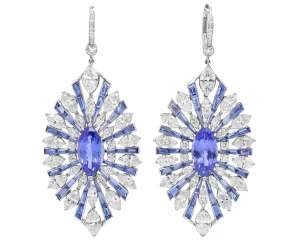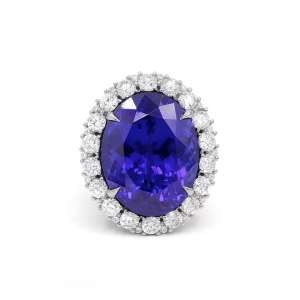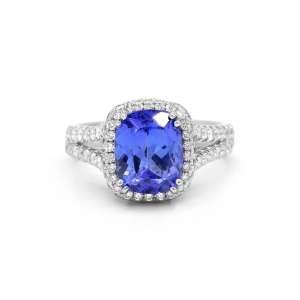Tanzanite’s allure stems not just from its breathtaking beauty but also from its scarcity, sparking curiosity about how it stacks up against the king of gems, the diamond. This comprehensive exploration, brought to you by COMPARE.EDU.VN, delves into the depths of gemstone rarity, comparing tanzanite and diamonds across key factors, and guiding you to informed decisions. Discover fascinating insights into formation, sources, value, and more, empowering you to appreciate the unique charm of each gemstone.
1. Understanding Gemstone Rarity
Gemstone rarity is a multifaceted concept influenced by several factors. These factors dictate the availability and, consequently, the desirability of various gems.
1.1. Factors Influencing Rarity
Several geological and market-related factors contribute to a gemstone’s rarity:
- Geological Formation: Unique geological conditions are needed for specific gemstone formation, making deposits rare.
- Geographical Location: Some gemstones are found only in limited geographic areas, further constraining their supply.
- Mining and Extraction: Difficult or limited mining operations can restrict the number of gems entering the market.
- Quality and Size: Gemstones of high quality and larger sizes are naturally rarer, commanding premium prices.
- Market Demand: High demand for a particular gem, coupled with limited supply, significantly increases its rarity and value.
1.2. Why Rarity Matters
Rarity plays a pivotal role in determining a gemstone’s value and desirability.
- Value Appreciation: Rarer gems tend to appreciate in value over time, making them attractive investments.
- Exclusivity: Owning a rare gemstone provides a sense of exclusivity and distinction.
- Collector’s Items: Rare gemstones are highly sought after by collectors, further driving up their value.
- Unique Jewelry: Using rare gems in jewelry creates unique, eye-catching pieces that stand out.
2. Tanzanite: A Geological Wonder
Tanzanite, with its vibrant blue-violet hues, is a relatively recent discovery in the gem world. Its unique geological origin and limited availability contribute significantly to its rarity.
2.1. Discovery and Origin
Tanzanite was first discovered in 1967 in the Merelani Hills of Tanzania, near Mount Kilimanjaro. This single, small geographic area remains the only known source of tanzanite in the world.
2.2. Geological Formation
Tanzanite’s formation requires extremely specific and rare geological conditions. It is a variety of zoisite, a calcium aluminum silicate mineral, formed under intense heat and pressure during the metamorphism of sedimentary rocks. The presence of trace amounts of vanadium gives tanzanite its distinctive color.
2.3. Limited Geographic Availability
The fact that tanzanite is found only in a small area in Tanzania makes it inherently rarer than gemstones found in multiple locations worldwide. Experts predict that the tanzanite supply may be depleted within a few decades, further increasing its rarity and value.
3. Diamonds: The Timeless Classic
Diamonds, renowned for their brilliance and durability, have been prized for centuries. While diamonds are found in various locations around the world, high-quality diamonds remain relatively rare.
3.1. Formation and Sources
Diamonds are formed deep within the Earth’s mantle under extreme pressure and high temperatures. They are composed of pure carbon atoms arranged in a crystal lattice structure. Diamonds are brought to the surface through volcanic eruptions of kimberlite and lamproite pipes. Major diamond-producing countries include Russia, Botswana, Canada, Australia, and South Africa.
3.2. Mining and Extraction
Diamond mining is a complex and resource-intensive process. It involves open-pit mining, underground mining, and alluvial mining. Only a small fraction of mined material contains gem-quality diamonds, making the extraction of valuable stones a challenging endeavor.
3.3. Abundance vs. Quality
While diamonds are found in multiple locations, gem-quality diamonds with exceptional clarity, color, and cut are relatively rare. The 4Cs of diamond grading (Carat, Clarity, Color, and Cut) significantly impact a diamond’s value, with flawless, colorless diamonds commanding the highest prices.
Alt Text: An aerial view of a large-scale diamond mine, illustrating the complex infrastructure and extensive operations required to extract diamonds from the Earth.
4. Tanzanite vs. Diamond: A Detailed Comparison
To accurately assess the rarity of tanzanite compared to diamonds, it is essential to compare them across several critical factors.
4.1. Occurrence
- Tanzanite: Exclusively found in the Merelani Hills of Tanzania.
- Diamonds: Found in various locations, including Russia, Botswana, Canada, Australia, and South Africa.
4.2. Formation Conditions
- Tanzanite: Requires very specific and rare geological conditions involving metamorphism and the presence of vanadium.
- Diamonds: Formed under extreme pressure and high temperatures deep within the Earth’s mantle.
4.3. Mining Output
- Tanzanite: Limited mining output due to the single geographic location and finite reserves.
- Diamonds: Substantial mining output, but gem-quality diamonds are a small percentage of total production.
4.4. Market Availability
- Tanzanite: Less readily available in the market compared to diamonds.
- Diamonds: Widely available in various sizes, qualities, and price ranges.
4.5. Value and Price
- Tanzanite: High-quality tanzanite can command significant prices, especially for larger stones with intense color.
- Diamonds: Prices vary widely based on the 4Cs, with flawless, colorless diamonds being the most valuable.
Table 1: Tanzanite vs. Diamond – A Comparative Overview
| Feature | Tanzanite | Diamond |
|---|---|---|
| Occurrence | Merelani Hills, Tanzania | Various locations worldwide |
| Formation Conditions | Rare metamorphic conditions | High pressure and temperature in mantle |
| Mining Output | Limited | Substantial, but gem-quality rare |
| Market Availability | Less readily available | Widely available |
| Value and Price | High for quality stones | Varies widely based on the 4Cs |



5. Quantifying Rarity: Numbers and Statistics
While it is challenging to provide an exact ratio of rarity between tanzanite and diamonds, some estimates and statistics can offer a clearer understanding.
5.1. Expert Estimates
Geologists and gemologists estimate that tanzanite is approximately 1,000 times rarer than diamonds. This estimate is based on the limited geographic occurrence and the finite supply of tanzanite.
5.2. Mining Statistics
The annual production of gem-quality tanzanite is significantly lower than that of gem-quality diamonds. While exact figures vary, the disparity in production volume underscores tanzanite’s relative rarity.
5.3. Market Data
Market data indicates that tanzanite accounts for a small percentage of the global gemstone market compared to diamonds. This further highlights the limited availability and rarity of tanzanite.
6. The Allure of Tanzanite
Beyond its rarity, tanzanite possesses several unique characteristics that contribute to its allure and desirability.
6.1. Unique Color and Pleochroism
Tanzanite is known for its trichroism, meaning it displays three different colors depending on the viewing angle. These colors range from violet-blue to blue-violet to reddish-purple, making each tanzanite stone unique and captivating.
6.2. Rarity and Exclusivity
The limited availability of tanzanite adds to its exclusivity and desirability. Owning a tanzanite gemstone provides a sense of distinction and appreciation for the rare wonders of nature.
6.3. Investment Potential
As tanzanite supplies dwindle, its value is expected to increase, making it an attractive investment for gemstone collectors and jewelry enthusiasts.
7. The Enduring Appeal of Diamonds
Diamonds have maintained their popularity for centuries due to their exceptional brilliance, durability, and timeless appeal.
7.1. Brilliance and Fire
Diamonds are renowned for their ability to refract and disperse light, creating brilliance and fire that captivate the eye.
7.2. Symbolism and Tradition
Diamonds have long been associated with love, commitment, and enduring relationships. They are the traditional gemstone for engagement rings and anniversary gifts.
7.3. Versatility and Style
Diamonds are versatile and can be incorporated into various jewelry styles, from classic solitaire rings to modern, avant-garde designs.
8. Factors to Consider When Choosing Between Tanzanite and Diamonds
When selecting between tanzanite and diamonds, it is important to consider your personal preferences, budget, and desired style.
8.1. Personal Preferences
- Color: If you prefer vibrant blue-violet hues, tanzanite may be the ideal choice. If you prefer the classic brilliance of colorless gems, diamonds may be more appealing.
- Style: Consider your personal style and the type of jewelry you prefer. Tanzanite can add a unique touch to contemporary designs, while diamonds complement both classic and modern styles.
8.2. Budget
- Tanzanite: High-quality tanzanite can be expensive, but it may offer better value for larger stones compared to diamonds.
- Diamonds: Prices vary widely based on the 4Cs, so it is possible to find diamonds that fit your budget.
8.3. Investment Potential
- Tanzanite: Its rarity and limited supply make tanzanite an attractive investment for long-term value appreciation.
- Diamonds: High-quality diamonds have historically retained their value, making them a reliable investment.
9. Jewelry Designs Featuring Tanzanite and Diamonds
Both tanzanite and diamonds can be incorporated into stunning jewelry designs that showcase their unique beauty.
9.1. Tanzanite Jewelry Designs
- Pendants: Tanzanite pendants make a striking statement, highlighting the gem’s vibrant color.
- Rings: Tanzanite rings are popular for their unique and eye-catching appeal.
- Earrings: Tanzanite earrings add a touch of elegance and sophistication to any ensemble.
9.2. Diamond Jewelry Designs
- Engagement Rings: Diamond engagement rings are a timeless symbol of love and commitment.
- Necklaces: Diamond necklaces add a touch of sparkle and glamour to any occasion.
- Bracelets: Diamond bracelets are a versatile accessory that complements any style.
Alt Text: A pair of elegant earrings featuring both diamonds and tanzanite, showcasing the harmonious combination of the two gemstones and their complementary visual appeal.
10. Caring for Tanzanite and Diamond Jewelry
Proper care is essential to maintain the beauty and longevity of your tanzanite and diamond jewelry.
10.1. Cleaning and Maintenance
- Tanzanite: Clean tanzanite jewelry with mild soap and warm water. Avoid ultrasonic cleaners and harsh chemicals.
- Diamonds: Clean diamond jewelry with a soft brush and mild soap. Ultrasonic cleaners are generally safe for diamonds.
10.2. Storage
- Tanzanite: Store tanzanite jewelry in a soft pouch or jewelry box to prevent scratches.
- Diamonds: Store diamond jewelry separately to avoid scratching other gemstones.
10.3. Professional Inspection
- Tanzanite: Have your tanzanite jewelry inspected by a professional jeweler annually to check for loose settings and potential damage.
- Diamonds: Have your diamond jewelry inspected by a professional jeweler annually to ensure the settings are secure and the diamond is in good condition.
11. Making an Informed Decision with COMPARE.EDU.VN
Choosing between tanzanite and diamonds is a personal decision that depends on your preferences, budget, and desired style. COMPARE.EDU.VN offers comprehensive comparisons and resources to help you make an informed decision.
11.1. Access Detailed Comparisons
COMPARE.EDU.VN provides detailed comparisons of tanzanite and diamonds, covering key factors such as rarity, value, and characteristics.
11.2. Read Expert Reviews
Benefit from expert reviews and insights that provide valuable information about tanzanite and diamonds.
11.3. Explore Jewelry Options
Discover a wide range of jewelry options featuring tanzanite and diamonds, allowing you to find the perfect piece that matches your style and preferences.
12. Conclusion: Embracing the Rarity and Beauty
Both tanzanite and diamonds possess unique qualities that make them highly desirable gemstones. Tanzanite’s extreme rarity and captivating color make it a standout choice for those seeking exclusivity and distinction. Diamonds, with their timeless brilliance and enduring appeal, remain a classic choice for symbolizing love and commitment. Ultimately, the decision of which gemstone to choose depends on your personal preferences and priorities. Let COMPARE.EDU.VN guide you in making the perfect choice.
Navigating the world of gemstones can be overwhelming, but COMPARE.EDU.VN is here to simplify the process. We offer comprehensive comparisons, expert reviews, and valuable resources to help you make informed decisions.
Are you struggling to compare different gemstones or jewelry options? Do you need help understanding the nuances of rarity and value? Visit COMPARE.EDU.VN today to explore detailed comparisons, read expert reviews, and discover the perfect gemstone that matches your style and preferences. Make your choice with confidence and embrace the beauty of informed decision-making.
Address: 333 Comparison Plaza, Choice City, CA 90210, United States
Whatsapp: +1 (626) 555-9090
Website: compare.edu.vn
13. Frequently Asked Questions (FAQ)
13.1. Is tanzanite more expensive than diamonds?
The price of tanzanite and diamonds varies based on quality, size, and other factors. High-quality tanzanite can be more expensive than lower-quality diamonds, but generally, diamonds command higher prices due to their overall market demand and perceived value.
13.2. Will tanzanite become more valuable in the future?
Due to its limited supply and increasing demand, tanzanite is expected to appreciate in value over time, making it a potentially lucrative investment.
13.3. Can tanzanite be worn every day?
Tanzanite is relatively soft compared to diamonds, so it is best suited for occasional wear. Avoid wearing tanzanite jewelry during activities that may expose it to scratches or impacts.
13.4. How can I tell if a tanzanite is real?
Authentic tanzanite exhibits trichroism, displaying different colors depending on the viewing angle. Consult a certified gemologist for a professional assessment.
13.5. What are the best settings for tanzanite jewelry?
Protective settings such as bezel or channel settings are ideal for tanzanite jewelry, as they help protect the gem from damage.
13.6. How does tanzanite compare to sapphires in terms of rarity?
While sapphires are found in multiple locations, high-quality sapphires with intense color are relatively rare. Tanzanite, however, is significantly rarer due to its single geographic source.
13.7. What is the Mohs hardness of tanzanite and diamonds?
Tanzanite has a Mohs hardness of 6.5 to 7, while diamonds have a Mohs hardness of 10, making diamonds much more durable.
13.8. Are there any ethical concerns associated with tanzanite mining?
Ethical sourcing is important for all gemstones. Look for tanzanite that is mined and traded in accordance with fair labor practices and environmental standards.
13.9. Can tanzanite be enhanced or treated?
Most tanzanite is heat-treated to enhance its color. This treatment is stable and widely accepted in the gem industry.
13.10. What is the best way to store tanzanite and diamond jewelry?
Store tanzanite and diamond jewelry separately in soft pouches or jewelry boxes to prevent scratches and damage.